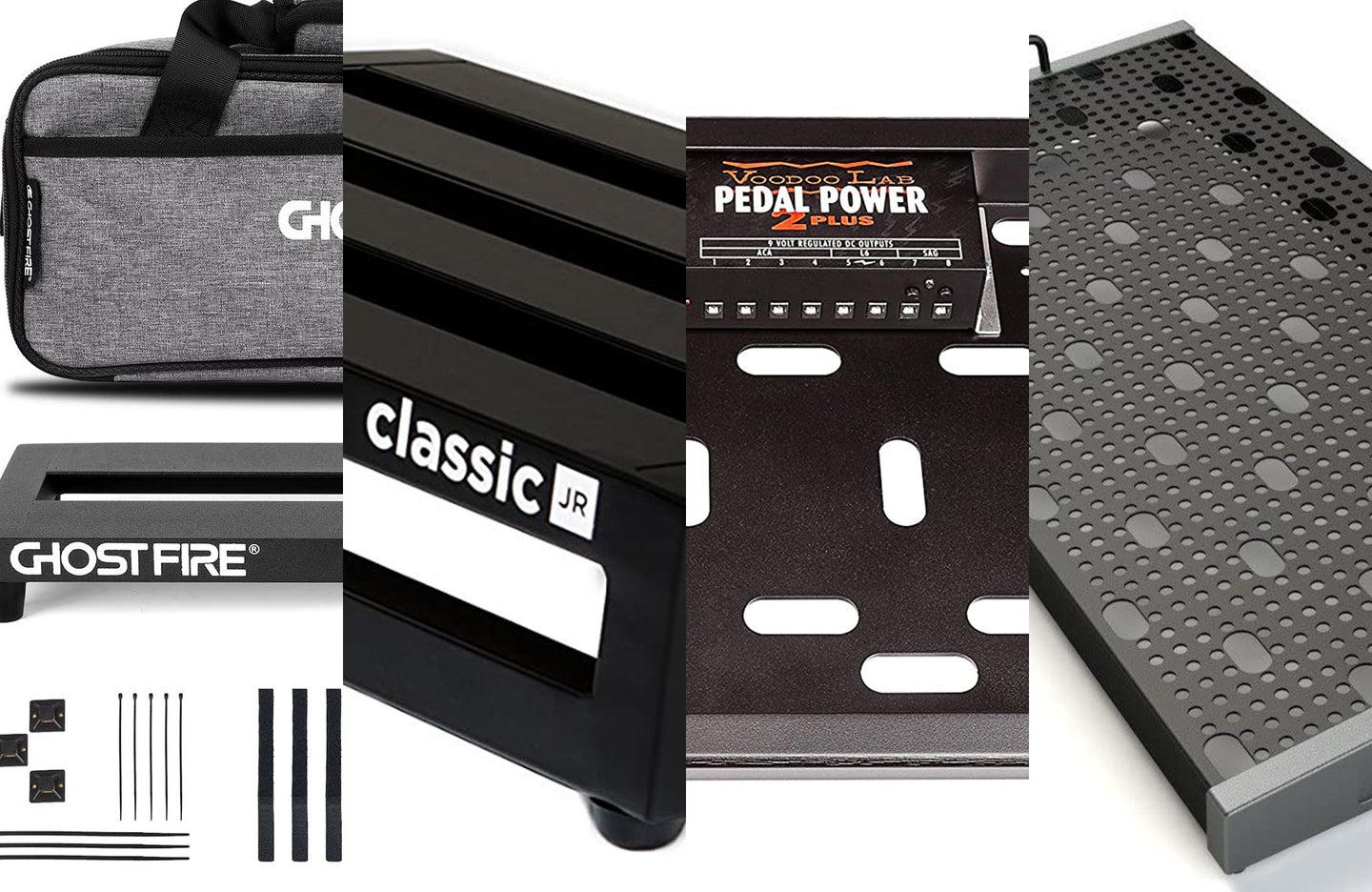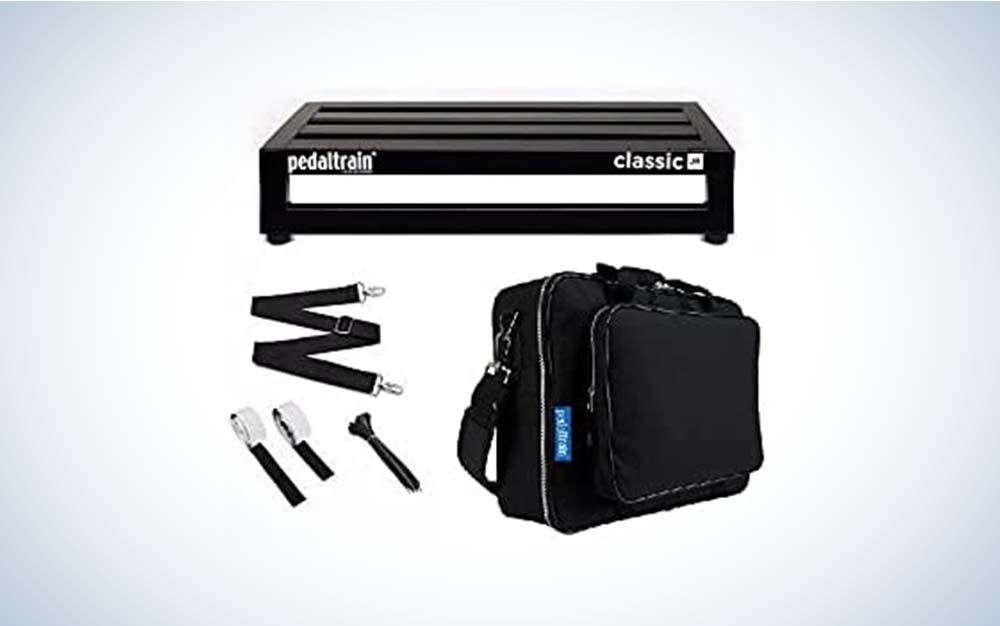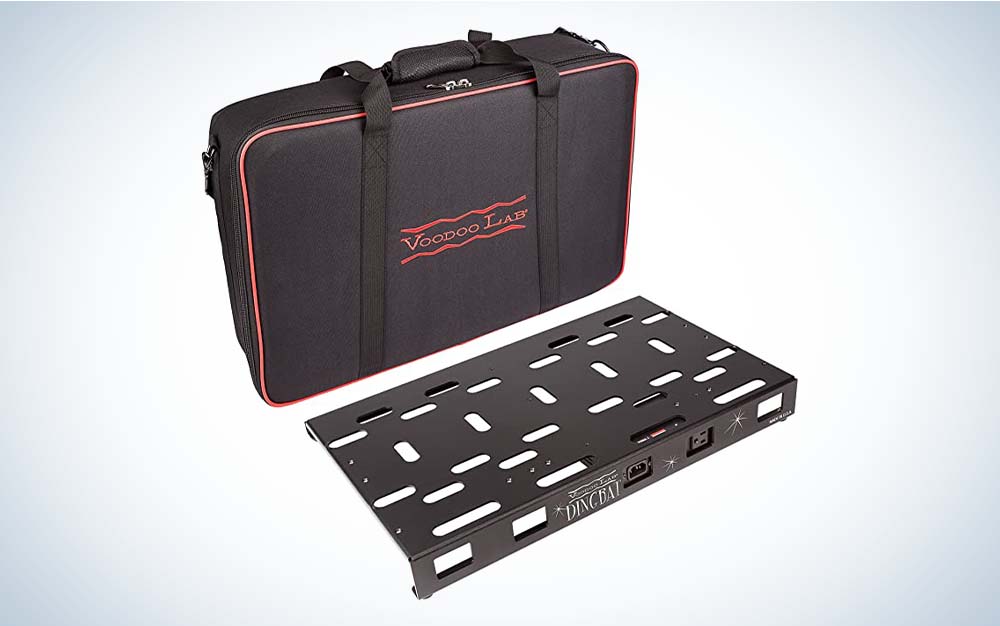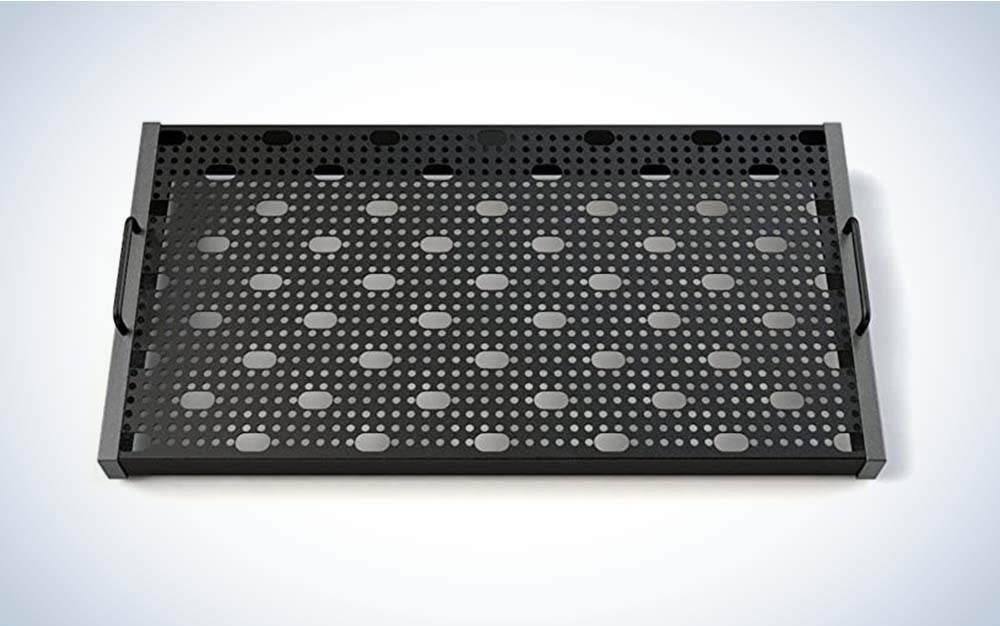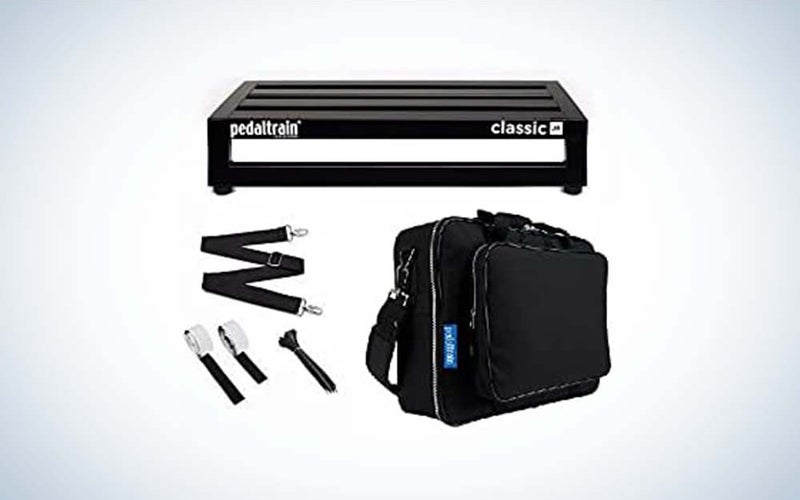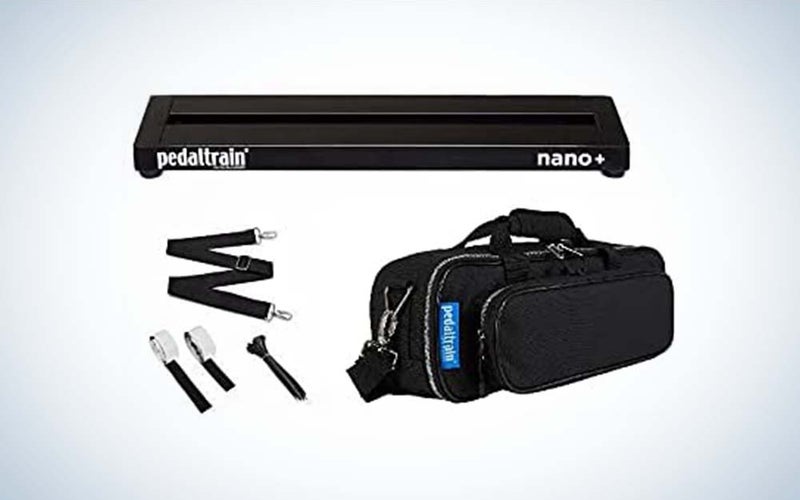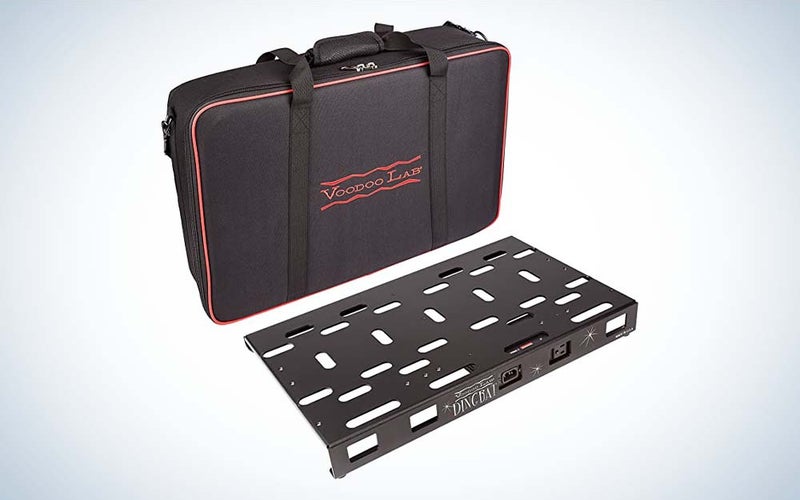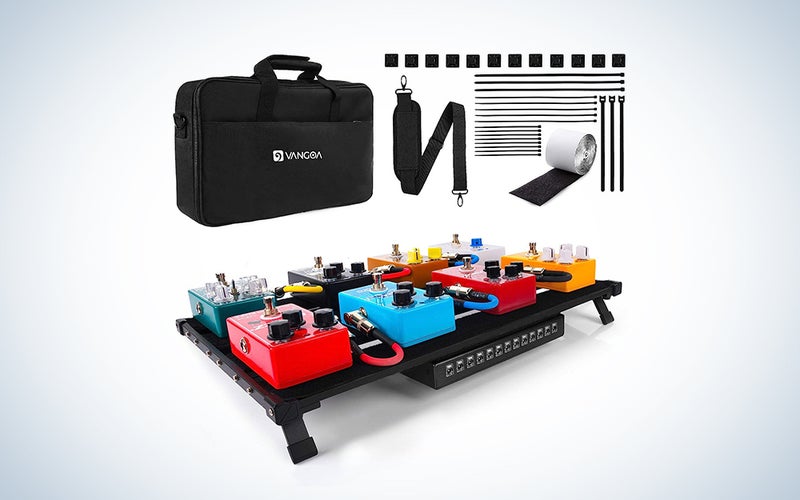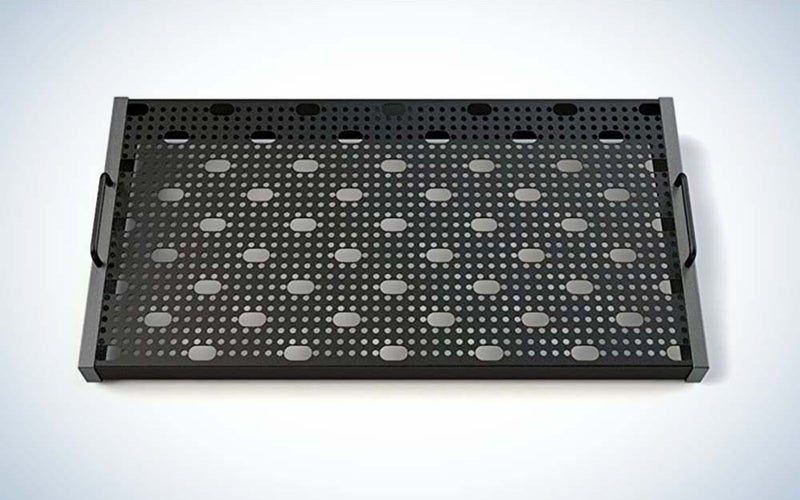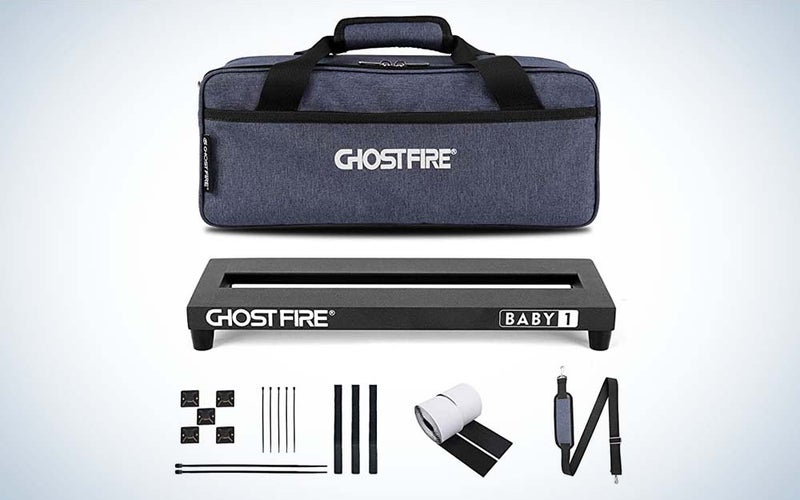We may earn revenue from the products available on this page and participate in affiliate programs. Learn more ›
The world of guitar pedals is one of endless sonic possibilities, and pedalboards are an essential tool for exploring that world uninhibited. Whether you’re an avid collector of effects pedals or you’re just getting started on your journey, installing your gear on a dedicated pedalboard is the best way to keep it organized, ready to use, and protected from damage. Some pedalboards come as standalone modular pieces, while others are packaged as a complete kit with a storage bag, power supply, and other essentials. Determining the best pedalboard for your particular needs comes down to how much gear you’ll be using at one time, whether you prefer a quick-and-dirty setup or a custom-tailored user experience, and the amount of flexibility you’ll require as your rig evolves.
- Best overall: Pedaltrain Classic JR
- Best small: Pedaltrain Nano+
- Best with power supply: Voodoo Lab Dingbat Medium Pedalboard
- Best with carrying case: Vangoa Guitar Pedal Board with Carrying Bag
- Best modular: Temple Audio DUO 24
- Best budget: Ghost Fire V-Baby 1
How we chose the best pedalboards
Durability is a key factor we considered when compiling this list. Each selection is built from aluminum, providing a stable and lightweight framework for the pedals, which are comparatively fragile and heavy in nature. Most of the pedalboards on this list also include a carrying bag or are compatible with a separately sold case, which is a must-have for protecting pedals from damage during storage and transport. Each of the selections on this list also utilizes either hook-and-loop fastening or thumb screws to keep pedals securely fixed to the pedalboard surface.
The best pedalboards: Reviews & Recommendations
A pedalboard is a creative tool, and as is true in most creative pursuits, finding the “best” pedalboard is a highly subjective experience that depends on the artist’s needs. With such a vast array of effects pedals available on the market—from the most basic tools like tuners and overdrive, to the most intricate harmonizers, filters, and oscillators—a pedalboard can truly be as simple or as complex as you want it to be. We’re constantly amazed by the increasingly powerful processing engines that can fit under our feet. We built this list of pedalboards based on the variety of creative situations and scenarios users will likely encounter when using pedals for electric guitars with a quality guitar amp. Each pedalboard on this list should perform well, regardless of the instrument used.
Best overall: Pedaltrain Classic JR
Pedaltrain
Why it made the cut: The Pedaltrain Classic JR has a sturdy aluminum construction and a moderate capacity that makes it fitting for a wide range of effects rigs.
Specs
- Pedal capacity: four large, ten regular, or twelve mini
- Surface dimensions: 18 x 12.5 inches
- Total weight: 6.46 pounds
- Bag included: Yes
- Fastening method: Hook and loop
Pros
- Generous capacity
- Case and adhesive included
- Angled for easy access
- Compatible with power supply mounts
Cons
- Large and bulky
- No power supply included
Nashville-based music company Pedaltrain is a leader in the pedalboard industry, with a name as recognizable as its minimalist hand-welded aluminum designs. The Classic JR is a great medium-sized offering from Pedaltrain that comes with either a soft case or a hard case and sports 216 square inches of surface area for your pedals. As is typical for most pedalboards on the market, the Classic JR comes with a roll of user-installable hook-and-loop tape for custom-tailoring of your pedalboard to your specific needs.
The Classic JR is compatible with Pedaltrain’s separately-sold power-supply mounting bracket, which allows users to cleanly install a power supply for their pedals underneath the board’s frame. This pedalboard’s angled surface allows users easy access to all of their pedals’ switches and controls, which makes a world of difference when making changes on the fly and marks an advantage over smaller designs. Still, this perk adds significant bulk that might not be welcome if packing light or setting up in a small space, so that’s something to consider if size is a concern.
Best small: Pedaltrain Nano+
Pedaltrain
Why it made the cut: The Nano+ from Pedaltrain is compact, but it still has enough space to accommodate an average-sized pedal setup.
Specs
- Pedal capacity: two large, six regular, or eight mini
- Surface dimensions: 18 x 5 inches
- Total weight: 3.04 pounds
- Bag included: Yes
- Fastening method: Hook and loop
Pros
- Enough room to fit a varied pedal rig
- Includes reinforced soft case
- Flexible size and lightweight contruction
Cons
- Limited space underneath
- Won’t fit longer pedals
- No power supply included
The scrappy 18-inch-long Nano+ from Pedaltrain is a great compromise for musicians who want portability from a pedalboard but aren’t keen on cutting out equipment for the sake of saving space. Users looking to string together one of each of the most common effects pedals—a tuner, distortion, modulation, delay, and reverb—will find that the Nano+ is perfectly sized to include one of each of these essentials with room to spare. This combination of flexibility and “just enough” capacity make the Nano+ a good choice for an everyday pedalboard that can easily move from the rehearsal studio to the stage with minimum fuss required.
Like all of Pedaltrain’s offerings, the Nano+ is constructed from welded aluminum for lightweight durability and it comes with 36 inches of adhesive-backed hook and loop for customizing your setup. The included fitted soft case is constructed to endure the rigors of travel, with heavy-duty zippers and extra reinforcement on stress points. The Nano+ is an exceptionally thin pedalboard that only rises 1.4 inches off the ground, so as with the V-Baby 1 above, you’ll need a low-profile power supply. It has two rails that can accommodate most common pedals, but you’ll want to size up to the three-rail Pedaltrain Metro 16 if you’re using a volume pedal or other unit that’s over five inches long.
Best with power supply: Voodoo Lab Dingbat Medium Pedalboard
Voodoo Lab
Why it made the cut: The Dingbat Medium’s 297-square-inch face has enough real estate for the most multi-faceted of professional pedal rigs, and it even comes with a power supply.
Specs
- Pedal capacity: five large, 10 regular, or 16 mini
- Surface dimensions: 22 x 13.5 inches
- Total weight: 11.15 pounds
- Bag included: Yes
- Fastening method: Hook and loop
Pros
- Includes carrying bag
- Tidy cable management
- Includes power supply
Cons
- Large and bulky
- Power supply is heavy
Voodoo Lab has been in the pedal game since 1986, and they’re known in particular for their Pedal Power supplies, a robust option for running effects rigs of every size. The company released their line of Dingbat pedalboards in 2017, and their medium size is an exemplary model of the best their design has to offer. The 297-square-inch Dingbat Medium is built from durable aircraft-grade aluminum and includes a single Pedal Power 2, which integrates seamlessly into the board’s underside. The design itself can accommodate up to two Pedal Power units to supply power for up to 16 pedals, making this a good pedalboard to grow with whether you’re a hobbyist or a working musician.
The surface of the Dingbat Medium features a number of punched-out holes for cable management to aid in keeping things visually tidy, and the included hook-and-loop and cable ties keep the setup secure. While this innovative and irregular surface undoubtedly grants a great deal of flexibility for custom setups, it can be time-consuming to install hook-and-loop onto this board when compared to simpler bar designs. Potential users should also keep in mind that Voodoo Lab’s power supplies are quite heavy, which is a testament to their quality but an important thing to consider if you’re going on the move.
Best with carrying case: Vangoa Guitar Pedal Board with Carrying Bag
Vangoa
Why it made the cut: This set comes with zip ties for cable management, a built-in power supply, and a convenient carrying bag to take your pedalboard to and from gigs.
Specs
- Pedal capacity: 8-10 compact pedals
- Surface dimensions: 17.7 x 11.8 inches
- Total weight: 2.4 lbs.
- Bag included: Yes
- Fastening method: Hook and loop
Pros
- Built-in power supply
- Lightweight
- Carrying case has a roomy front pocket
Cons
- Pedalboard only inclines 5 degrees
Getting to the gig can be a little difficult when you don’t have a car. Make the trip easier with this pedalboard from Vangoa, which comes with a carrying case with built-in handles and a padded strap. Use the padded strap when your hands are full of instruments and/or amps, and use the handles when the gig requires just you and your guitar. The pedalboard itself is lightweight at 2.4 lbs., and inclines at 5 degrees for easy pedal access with room for your cables. Speaking of, the kit comes with zip ties to keep the underside of your pedalboard from looking like the passenger seat of your drummer’s car: messy! If you’re a musician on the go and have to strategize what you’re bringing, the Vangoa pedalboard and included case can take at least one line item off your “things to worry about before the show” list.
Best modular: Temple Audio DUO 24
Temple Audio
Why it made the cut: Temple Audio’s pedalboard system grants users access to the flexibility, control, and organization required in the most demanding working environments.
Specs
- Pedal capacity: six large, 12 regular, or 24 mini
- Surface dimensions: 24.5 x 12.5 inches
- Total weight: 4.6 pounds
- Bag included: No
- Fastening method: Thumbscrew plates
Pros
- Highly customizeable
- Secure fastening
- Visually tidy and easy to organize
- Custom modules for endless sound configurations
Cons
- All pieces sold separately
- Cost of components can add up
- Above-average user installation required
- No bag or fasteners included
Unlike the other pedalboards on our list, the DUO 24 from Temple Audio is a standalone centerpiece for an expansive ecosystem of modular components and a-la-carte pieces. Aimed at delivering the tidiest and most space-efficient pedalboard experience possible, Temple Audio’s pedalboards are a blank canvas ready to be outfitted with user-selected components, including a variety of proprietary I/O modules such as effects loops and direct boxes. Due to the highly customizable and modular nature of this unit, it’s more suitable for adventurous users with spare time and dreams of a tidy, organized pedalboard.
The DUO 24 dumps hook-and-loop fastening in favor of an adhesive plate system for affixing users’ pedals to the board’s surface using thumbscrews. This facilitates quicker position changes when swapping pedals on the fly, and it also limits visual clutter on the board itself. Optional side-mounted modules grant users access to a host of options, including IEC mains power, USB power, and more, making this a true dream for the musically-inclined tinkerer.
While this is a fantastic option for giving your pedal rig a bespoke treatment, Temple Audio’s pieces are all sold separately and require user installation. For example, the pedal mounting plates come in three different sizes and are all sold individually; bags and power supplies are also sold separately. This is the appeal of Temple Audio’s stylish and highly customizable system, but the combination of extra financial investment and required setup time may turn off some users.
Best budget: Ghost Fire V-Baby 1
Ghost Fire
Why it made the cut: The V-Baby 1 from Ghost Fire is an affordable mini pedalboard that’s durable and easy to move around.
Specs:
- Pedal capacity: two large, four regular, or six mini
- Surface dimensions: 13.7 x 5.5 inches
- Total weight: 2.62 pounds
- Bag included: Yes
- Fastening method: Hook and loop
Pros
- Includes carrying bag and adhesive
- Very lightweight and portable
- Great for minimalist setups
Cons
- Limited space underneath
- Relatively small capacity
- Won’t fit longer pedals
- No power supply included
The V-Baby 1 is an aluminum pedalboard from Ghost Fire that offers just enough space for four regular-sized pedals, making it a great choice for auxiliary setups or stripped-down configurations. It includes a soft-handled carrying bag with an oxford-cloth finish and a carrying strap, plus a generous amount of hook-and-loop and cable ties. Without the bag, the metal frame of the pedalboard weighs just over one pound, so it’s also a stellar option if you’re flying or otherwise traveling light.
Measuring in at just 1.9 inches high, the V-Baby 1 has a slick low profile that will take up hardly any space while in use or in storage. If you’ll be using an underside-mounted power supply, bear in mind that this pedalboard’s low clearance can only accommodate units less than 1.37 inches thick, so you’ll need to go with a low-profile option like the Truetone 1SPOT PRO CS6. Many power supplies come with mounting equipment like brackets and screws, but hook-and-loop may be more conducive to the quick-and-easy user experience that this form factor inspires.
Related: Universal Audio guitar pedal comparison: Which amp emulator is right for you?
What to consider when buying the best pedalboards
There’s much to factor in when buying the best pedalboards. Here are some of the biggest considerations to make before clicking “add to cart”:
What size pedalboard do you need?
It’s a bit more complicated than taking stock and buying the biggest model. When in doubt, context is key. If you’re a minimalist and you have a small collection of pedals that you’re not looking to expand, a small pedalboard is probably a good choice for you; however, if you’re an avid collector and you want to take a skeleton version of your setup to a rehearsal, you might also want a small pedalboard. Larger pedalboards allow room to grow, but they also offer more possibilities for tinkering and experimenting with new sounds; however, they’re no fun to transport, and they’re rarely practical for long-term touring unless every pedal is absolutely necessary.
How much power do you need?
Unless you’re daisy-chaining a small number of low-powered pedals, you’ll need to mount a power supply somewhere on your board. Most users prefer to mount power supplies below the pedalboard to avoid stealing real estate from the pedals themselves, but not every board has space below to accommodate every power supply. Shorter pedalboards will absolutely require a low-profile power supply, while pedalboards that sit higher over the ground can accommodate bulkier supplies like the Voodoo Lab Pedal Power 2 Plus.
Is this a semi-permanent setup, or do you need flexibility?
Because pedals require some measure of fastening to a pedalboard for proper security, they can be somewhat difficult to move around and keep tidy. This is especially true when using cable ties. If you plan to make frequent changes to your pedal order and your setup overall, consider either keeping all your effects together on a larger board with cable management, or opting for a modular pedalboard without hook-and-loop.
FAQs
Q: How much does a pedalboard cost?
A pedalboard can range between $40-$400, depending on size and features.
Q: What’s the best pedalboard power supply?
When shopping for a pedalboard power supply, sufficient output wattage and individual isolated outputs are a must for keeping pedals protected from damage and running properly. The Pedal Power 2 PLUS from Voodoo Labs provides power for up to eight pedals simultaneously, with four 9-volt/12-volt outputs offering 100 milliamps, two 9-volt outputs providing 250 milliamps, and another pair of 9-volt outputs running at 100 milliamps with emulated battery power sag.
Q: What’s the best pedalboard setup?
Half the fun of playing with pedals stems from creativity and experimentation, so there are no hard-and-fast rules when it comes to pedalboard order. If you’re looking for a place to start, a good baseline pedal order is as follows: (1) tuner; (2) pitch shifting effects; (3) compression; (4) fuzz and distortion; (5) delay; (6) modulation effects, like tremolo and vibrato; (7) reverb.
Q: What’s the best pedalboard tuner?
The Boss TU-3 is one of the best pedalboard tuners thanks to its high-brightness LED meter, multiple chromatic and instrument modes, and its nearly indestructible stompbox housing. If you’re trying to save space on your pedalboard, try a mini tuner like the KLIQ TinyTune.
Q: What are the best pedalboard cables?
Cables with relatively flat head jacks are the best option for keeping pedalboards tidy and making the most out of limited space. A pack of cables with pancake-style jacks is a good bet, or if you’re looking for something with better longevity, you could make your own using a solder-less kit like the Evidence Audio Monorail.
Final thoughts on the best pedalboards
- Best overall: Pedaltrain Classic JR
- Best small: Pedaltrain Nano+
- Best with power supply: Voodoo Lab Dingbat Medium Pedalboard
- Best modular: Temple Audio DUO 24
- Best budget: Ghost Fire V-Baby 1
As you can see, pedalboards come in all shapes and sizes, and it’s really up to the user to fill up a board however they see fit. Everyone uses different pedals, and every musician has their own creative needs. In general, smaller pedalboards are great for taking to rehearsals, bringing on the road, and storing a streamlined effects setup. Larger boards tend to offer more cable management systems and accommodate bulkier gear, but this added capacity comes at a cost in portability. When all is said and done, determining the best pedalboard for your needs starts with the gear you’re bringing to the table and ends wherever you plan to follow your creativity.
Why trust us
Popular Science started writing about technology more than 150 years ago. There was no such thing as “gadget writing” when we published our first issue in 1872, but if there was, our mission to demystify the world of innovation for everyday readers means we would have been all over it. Here in the present, PopSci is fully committed to helping readers navigate the increasingly intimidating array of devices on the market right now.
Our writers and editors have combined decades of experience covering and reviewing consumer electronics. We each have our own obsessive specialties—from high-end audio to video games to cameras and beyond—but when we’re reviewing devices outside of our immediate wheelhouses, we do our best to seek out trustworthy voices and opinions to help guide people to the very best recommendations. We know we don’t know everything, but we’re excited to live through the analysis paralysis that internet shopping can spur so readers don’t have to.
